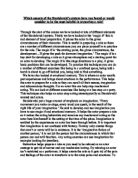“The purpose of the System is to create the right conditions for the subconscious to be roused to creative work, especially in the case of actors who have talent rather than genius, like Stanislavski himself.”
This means that the purpose of the System is to make a realistic performance and get rid of any ‘false acting’. The director plays a part in this as it is he who directs what the actors will do, and therefore determines how lifelike the performance will be.
The psychotechnique aspect of the System is what the actors work with inside themselves, as opposed to what the audience can directly see them doing on the outside e.g. walking across the stage. The psychotechnique creates the atmosphere which can be felt by the audience and the inner actions are also linked to the actions which an actor performs externally.
One of the elements of the psychotechnique is Given Circumstances. These may be used by the director in preparation for a performance, and they are closely analyzed. The Given Circumstances is everything that the director and actors are given to work with. Stanislavski said that the Given Circumstances are “the story of the play, the facts, events, epoch, time and place of action, conditions of life” (An Actor Prepares). A director would use the Given Circumstances in order to fulfill the playwright’s aim in the play.
An example of when the director might use the Given Circumstances is when he directs the play according to when and where it is set. As well as setting the costume, lighting and sound according to the Given Circumstances, he would also direct the actors to react accordingly with how a person in that time and place may respond.
If I was to direct a scene from ‘The Crucible’ by Arthur Miller, I would look closely at the Given Circumstances. This play is based on the facts of a witch-hunt at the time which resulted in many innocent people being hung. I would use these, and other, Given Circumstances to direct the actors according to them.
I think that using this technique would definitely be useful in directing a performance. It would be successful in most circumstances unless a director wanted to change the aim of the performance and make it different from the aim that the playwright originally gave the play.
Another way a director might use the psychotechnique in the System is by deciding on a Super-objective and using this throughout the process. The Super-objective is the overall objective for the performance, which they will decide upon before rehearsals begin. This Super-objective is on the director’s and actor’s mind throughout the whole rehearsal process. By deciding upon this Super-objective, the director is building the inner world of the characters and each thing that the actors make happen in the performance is building towards this Super-objective, which is important for the director.
Stanislavski said, when talking about the Super-objective:
“In a play the whole stream of individual minor objectives, all the imaginative thoughts, feelings and actions of an actor should converge to carry out the Super-objective”.
This is important for a director because whatever each actor’s own objective is for the play, the director must make sure that it blends together to carry out the Super-objective. A director would use this aspect of the System throughout the rehearsal process in order to effectively convey the super-objective.
I performed in scenes from ‘Yerma’ by Lorca and decided on a Super-objective to apply to the play as a whole, which was similar to what Lorca himself, the playwright, had probably intended. By using this, I could effectively apply the Super-objective to certain scenes in the play, by getting the actors to internally think about this, and therefore convey this Super-objective to the audience indirectly.
I think that this aspect of the System is effective and helpful for a director to use as he can direct the play and the actors appropriately and give a message to the audience without directly telling them the objective.
In conclusion, Stanislavski thought the role of the director is very important as it is the director who is involved with every aspect of the play. The psychotechnique in the System is useful and successful for a director to use, as it helps the play to develop and become more meaningful and realistic.







